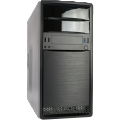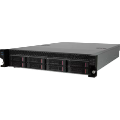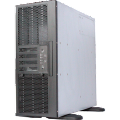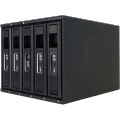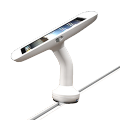CASE STUDY - 2U, 6 Node Server systems
Recently, because the rise of the small-scale data centers, the need of the adroit computing and storage systems is growing. Many enterprises start to search for a more economic and flexible solution besides the blade system. The node system is becoming the trend because it has at least 3 advantages over the blade systems: compact size, easy installation, and flexible cost.
Usually, the node size of the node system is smaller than the blade system, so it can be realized in 1U, 2U server chassis, rather than the 6U or 8U chassis which is commonly used in the blade system. The room for the servers can be reduced and be more efficient, especially when only few computing nodes is required in small business. More additional room can be used to expand the storage servers or additional node servers when they are required.
The compact size also brings the mobility and convenience when moving or settling the machine. You can easily transfer the machine to other rack without help. Best of all, the cost can be controlled. Owners don’t have to buy a big, multiple slots blade server when they only need few computing nodes. A few 2U 4 nodes systems or one 4U 8 nodes systems can satisfied the duty in the most time. They can decide to expand the computing center later when their business grows by adding more machines. Because of the high flexibility in size and mobility, the node systems are commonly used as the core of the emerging hyper-converged systems.
Requirement
In this case, our client asked for a customized node system. It requires 18 HDD bays, but need to contain 6 node system, each owns 3 HDD resource and is empowered by one 2U redundant power supply. This configuration is really hard to be realized by the standard chassis on the market.
Realization
In the design stage, we first check the size of the components to see if they can be included in. Soon we found the problem: though the motherboards of the 6 nodes from our clients is smaller than other companies, they can only be put in the rear side when there’s no power supply. The redundant power supply is the barrier.
We tried to propose the solution to our clients to use the flex power supply. However, it is too dangerous to use single power supply for the high density nodes system with large HDD array. One blackout may cause pandemic system failure and irreversible damage to the hardware and the data. Using single power supply isn’t practical.
We then did the brainstorm to find several solutions, including canceling few HDD trays or ask our clients to further reduce the size of the motherboard. We even asked if our client can change the spec to shrink from 6 to 4 nodes. Finally, we came out one bold idea: why not separate the redundant power supply?
It is reasonable because the redundant power supply is actually the composite of two individual power supply module. If we can separate the power supply into two units, each individual module can be perfectly arranged in the front side and the rear side. All we needed was a customized power distribution board.
Fortunately, motherboard design is not a problem for our clients. It is also not so hard to change the power distribution board. The 2U 6 nodes system was realized successfully.




